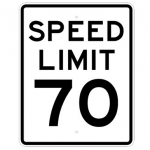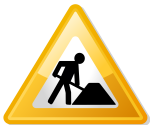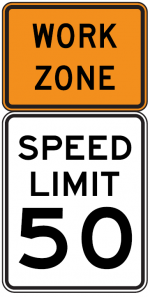US, State, and County Route Naming
The following naming conventions are used in Illinois for US, State, and County route naming.
US Highways ![]()
US Highways (or routes) are named in Illinois using the standard US Road Naming guidelines. The base format of the name for these road types is:
- US-66 For U.S. Route 66
State Highways (Routes) ![]()
Illinois state highways are named as follows:
- SR-23 For Illinois Route 23
- SR-23 S For Illinois Route 23, Southbound
- SR-23 BUS For Illinois Route 23 Business
- SR-23 BUS N For Illinois Route 23 Business, Northbound
- SR-23 ALT For Illinois Route 23 Alternate
- SR-23 ALT S For Illinois Route 23 Alternate, Southbound
- Note: BUS must be completely in uppercase when used for proper TTS
County Highways ![]()
County highways in Illinois are named with a "CH" prefix as illustrated below.
- CH-4 For County Highway 4
- CH-4 S For County Highway 4, Southbound
- Where Counties have highway designations beginning with a letter, the format looks like this:
- CH-T4 For County Highway T4
- CH-T4 E For County Highway T4, Eastbound
Proper sourcing of county routes and highways is important for applying road type guidance (Road types). CH may or may not always be shielded. Sources other than WME SV may need to be used. The interactive IDOT functional classification map uses a third-party base map source which is subject to copyright restrictions and may not be correct, therefore, it should not be used as a source for naming information. In order of preference, source county route/highway numbering from WME SV images less than three years old (consult LAM or SM if images are older), published county information, or the IDOT county highway maps available at IDOT Maps.
County Roads
Rural counties in Illinois employ a geographic coordinate system to name roads outside established communities. These roads are prefixed with a "CR." These names employ a number and a cardinal direction, general north (N) or east (E) of a specified locus. For example:
- CR-1000 E Refers to county road 1000 E
- CR-3000 N Refers to county road 3000 N
Township Roads
A select few counties may employ township roads. Please consult with the state managers before editing names of township roads.
Road Type (Functional Classification)
Illinois follows standard USA guidance (Road types) for assignment of road type assignment. It is important to remember that the interactive IDOT map uses a base map that may have yellow colored roads that are not collectors. Minor collectors are bright yellow.
Turning Restrictions
The provisions for turning in Illinois are defined in Rules of the Road, in Illinois Compiled Statutes 625 ILCS 5/11. In this wiki section we cover two specific situations: Left turns across medians and U-Turns.
Left Turns across Medians
Left turns across paved non-curbed medians are allowed in Illinois, defined in 625 ILCS 5/11-708 (e).
The Illinois Department of Transportation (IDOT) defines several types of medians in Bureau of Design and Environment Manual Ch. 34, Cross Section Elements:
- Flush - A median which is adjacent to traffic lanes and on the same plane as the lanes. These are painted on the pavement surface.
- Depressed - The median between opposing traffic lines is slightly below the elevation of the traffic lanes. It is also designed for drainage and storage of plowed snow.
- Raised-Curb - The curb on these medians is greater than two inches in height.
- Traversable - This type of median has a curb two inches in height.
A Two-Way Left Turn Lane (TWLTL) is typically a flush median. IDOT allows a traversable median to be used as a TWLTL in place of a flush median.
U-Turns
In Illinois, U-Turns can be performed unless specifically prohibited by law. Illinois statute defining the limitations on U-Turns is 625 ILCS 5/11-802 and can be reviewed in the Illinois Secretary of State Rules of Road booklet.
U-Turns can be enabled when editing by enabling the U-Turn flag or at box (#) and partial-box (H) intersections when the median segment is more than 15m in length (See Avoiding U-turns in box and partial box intersections).
When considering enabling a U-Turn, do so only if there is a strong potential to provide improved routing. Some examples of U-Turn implementations are:
- Where driveways or parking lots are connected to a median-divided roadway and doing so would eliminate complex routing to reach the proper side of the road.
- At both connected end-points of a single segment parking lot or gas station to provide an optimal exit route.
Before enabling a U-Turn on public streets, these conditions should be met:
- No traffic control devices posted prohibiting the movement.
- The movement may not be performed on a curve.
- The movement may not be performed on a hill or incline.
- A driver must be able to see in all directions on all roadways a at least 500 feet (153 meters).
- The turn must be able to be completed as a single continuous movement. While not a legal requirement, is best practice for safer navigation.
- At least 15 meters (49 feet) exist from the left edge of the legal departure lane to the right edge of the destination lane, including any median to the left of the departure lane, to allow single continuous movement.

Speed limits
Illinois follows the general speed limit guidelines for the USA with this local guidance.
In addition to posted speed limits, Illinois has several default speed limits that are applicable in different circumstances. These are defined in Illinois Compiled Statutes 625 ILCS 5/Ch. 11 Art. VI (Speed Restrictions) with supporting information in 625 ILCS 5/Ch. 1 (Definitions). The maximum speed limits to be used are for private passenger vehicles.
The default speed limits that should be added to the Waze map in Illinois are:
- Interstates and tollways — 70 mph.
- Highways with four lanes, having a separation between roadways moving in opposite directions — 65 mph.
- Other highways, roads and streets (non-urban areas) — 55 mph.
- Other highways, roads and streets (urban districts) — 30 mph.
The counties of Cook, DuPage, Kane, Lake, Madison, McHenry, St. Clair, and Will, may set maximum speed limits lower than the state defaults.
An urban district is "The territory contiguous to and including any street which is built up with structures devoted to business, industry or dwelling houses situated at intervals of less than 100 feet for a distance of a quarter of a mile or more." [625 ILCS 5/1-214]
Illinois default speed limits not currently applicable and not to be added to the Waze map:
- Alleys — 15 mph.
- School Zones — 20 mph (on school days between 7 a.m. and 4 p.m. when children
are present and signs are posted).
School and park speed limits
These special zones are not added to the map. At the present time there is no way to support the time- and condition-based aspects of speed zones at schools and parks. The speed limit before entering one of these zones should be carried through, in the direction of travel, to the point the special speed zone ends.
Work zone speed limits


A work zone (WZ) may have a lower advisory speed limit (SL) posted in black on orange
![]() , or a regulatory speed limit posted in black on white with an orange "Work Zone" banner across the top
, or a regulatory speed limit posted in black on white with an orange "Work Zone" banner across the top ![]() .
.
We only consider the regulatory signs, and never map advisory speed limits.
- Only add Work Zone speed limits (WZSL) if they are anticipated to persist more six months.
- For projects expected to last less than six months:
- Use the regular underlying SL on affected segments.
- Document the WZSL as a [CONSTRUCTION] UR with the keyword
WZ: mphincluded in the text. Also include area under construction and expected completion date.
- For projects scheduled to continue for more than six months:
- Document the construction in a [CONSTRUCTION] UR, including: Area/segments involved, expected completion date, original speed limit using
SL: mph, and work zone speed limit usingWZ: mph(example:SL: 45 / WZ: 35). - Update affected segments with posted WZSL.
- Document the construction in a [CONSTRUCTION] UR, including: Area/segments involved, expected completion date, original speed limit using
- Projects of shorter duration may be added as well, IF the editor has access to frequent status updates on the project, and is willing to monitor and adjust as soon as the SL is restored.
Where speed limits change
In Illinois, speed limit changes are mapped at the point nearest the posted speed limit sign with these considerations:
- Changes should be mapped at or before the sign in the direction of travel..
- Changes should be mapped at definite changes in roadway characteristics: urban boundaries, intersecting roadways, or driveways, etc.
- Changes should not be mapped less than 200 feet from an existing junction. This can have a negative impact on turn delay calculations.
If an editor has any questions regarding the placement of a speed limit change or feels discussion is needed regarding an exception to these guidelines, please reach out to area managers.
True Elevation
In Illinois, an expanded implementation of the general guidance for elevation and overpasses, underpasses, and bridges, has been adopted. Please refer to the these sections for additional guidance.
True Elevation refers to relative layers of road decks supported above and below the terrain (ground) with open space between them. In essence, adjusting the segment elevation like a layered cake as segments pass above, or below, terrain features and other segments.
What is an overpass? An overpass is a general term for any road, walkway, railroad, bridge, or other mapped structure crossing over an impediment such as a waterway, natural formation, or another road, walkway, railroad, or bridge. In our mapping context it can also be conceptualized underground where tunnels crossing over, or under, one another.
Elevation
Apply these points to the use of true elevation:
- All roads when not supported above or tunneled below the terrain are set to ground elevation unless otherwise noted.
- If a road segment is supported above the terrain or another road segment, the elevation of the segment should be set one higher (+1) than the segment or terrain (ground) immediately beneath.
- The elevation of road segments completely or transitionally sub-surface should be negative and one less than (-1) the surface, tunnel, or level immediately above.
- Ramps are to be set to the lower elevation of the roadways to which they junction unless passing over or under other segments.
Segmentation
When creating segments to implement this guidance, please observe these precepts:
- Create junction nodes for elevation purposes at the point the physical change in elevation occurs unless otherwise specified.
- Do not cut a segment within 200 feet (60m) of an existing junction.
- Do not create a segment less than 200 feet (60m) in length.
- Underground segments should be cut at least 50 feet (15m) before, or after, the entrance to the subterranean section.
- Check the tunnel option for any underground segment.
Culverts
A culvert is a tunnel allowing a stream or open drain to pass under a roadway. Under normal circumstances these are not to be mapped. However, an elevated segment for a culvert may be created to support real-time closures (due to significant flooding or repair) when all these conditions are met:
- The culvert is of significant construction requiring multiple day closures to repair or has major flooding potential.
- The culvert not located near the center of the segment.
- The segment is heavily populated by potential destinations and a route to the wrong end of the segment would result in a un-routed detour of more than one mile.
Locking standard
The following defines a set of minimum locking standards proposed for all roads within Illinois. Any road of a certain segment type must be locked at least to the level in the chart below. Roads may be locked higher for protection and special situations (areas with construction, tricky design, frequent mistakes, imaging inaccuracies, and the like), but should not be locked lower.
It is understood that more rural or inactive areas may not yet meet this standard: editors are encouraged to recruit and mentor additional editors to build state-wide coverage.
A great time to implement these locks is while bringing the road types of an area into compliance with the current US road type standards (FC and highway systems). Lock the roads based on type after they've been set to current US Road Type Standards.
| Segment Type | Two-way | One-way | Chicago Zone | |||||||||
|---|---|---|---|---|---|---|---|---|---|---|---|---|
| Freeway | 5 | |||||||||||
| Ramp | Highest rank of connected segment | |||||||||||
| Major Highway | 3 | |||||||||||
| Minor Highway | 3 | |||||||||||
| Primary Street | 2 | 3 | ||||||||||
| Street | 1 | 2 | 3 | |||||||||
| Private Road | 1 | 2 | ||||||||||
| Parking Lot Road | 1 | 1see note | 2 | |||||||||
| • • • • Ferry • • • • | 5 | |||||||||||
| |-|-|-|-|-|-|-|-|-| Railroad |-|-|-|-|-|-|-|-|-| | 2 | |||||||||||
| ⁃ ⁃ ⁃ ⁃ ⁃ Runway ⁃ ⁃ ⁃ ⁃ ⁃ | 5 | |||||||||||
| Other named types | 1 | 3 | ||||||||||
| Construction (outdated imagery) | 3 | |||||||||||
Note: One-way PLRs used outside of parking lots, such as alleys and streets through apartment complexes, should be locked at 2. The Chicago Zone is bordered by Lake Michigan on the east, the Chicago River on the north and west and Polk on the south. See the GLR major roads page for additional information on the standards listed here.